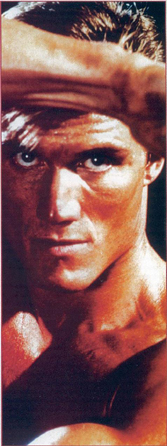
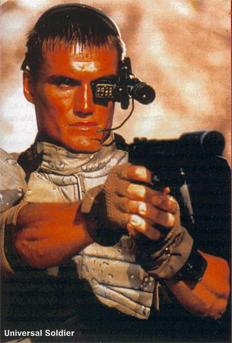
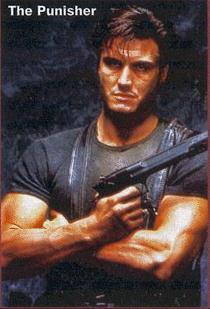

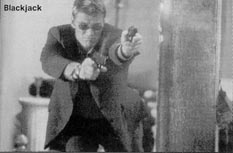
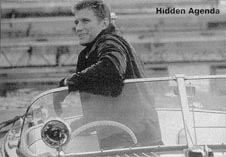
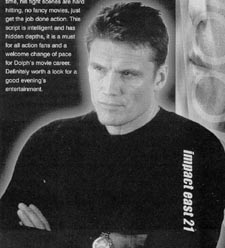 |
Dolph Lundgren
Interviewed
By Tracy Baldock,
Impact
(UK), May 2002
Dolph Lundgren is living proof
that brains and brawn do go together. Born on 3rd November 1957
and raised in Stockholm, Sweden, Lundgren attended the Royal
Institute of Technology. Spending time abroad in the United States
on various academic scholarships, he attended Washington State
University and Clemson in South Carolina. In 1982, he received
a scholarship to complete his Masters degree in Chemical Engineering
at the University of Sydney in Australia. The following year,
he was awarded a Fullbright Scholarship to the world-renowned
Massachusetts Institute of Technology. While on his way to Boston
to continue his studies, he stopped in New York City and there
his life took a radical turn.
While working at the trendy Limelight
Disco along side actor Chazz Palminteri, Lundgren met with noted
drama coach Warren Robertson, and decided to give acting a try.
Lundgren made his feature film debut in the James Bond movie
A View to a Kill (1985), which co-starred his then lover Grace
Jones. He followed that by beating 5000 other hopefuls to land
the breakthrough role of Ivan Drago, Sylvester Stallone's opponent
in Rocky IV (1985) . The success of this film led Lundgren
to star in numerous films including Masters of the Universe
(1987), The Punisher (1989), Showdown in Little Tokyo
(1991) opposite the late Brandon Lee, Universal Soldier (1992)
and Johnny Mnemonic (1995). In 1993, he starred in Pentathlon
(1994), an action-drama which his production company, Thor
Pictures (also known as Red Orm Productions) financed.
While most of his films tend
to typecast him as a bicep-bulging hero, Lundgren is also a founding
member of 'Group of Eight', a New York theatre group started
in 1994 which performed Another Octopus. A world-class
athlete, Lundgren took up martial arts at fourteen and has achieved
a third degree black belt in Kyokushinkai Karate. His accomplishments
in the sport include the captaincy of the Swedish full-contact
Karate team and the winner of the European Heavyweight Full-Contact
Karate Championship in 1980 and 1981, as well as the Australian
heavyweight division title in 1982. Lundgren's lifelong interest
in physical fitness led to his 1987 workout video called Maximum
Potential. In addition to his Karate expertise, he was selected
to serve as the Team Leader of the 1996 U.S. Olympic Pentathlon
Team. He dated model Paula Barbieri who was also O.J. Simpson's
ex-girlfriend and is now married to Annette Qviberg Lundgren,
a jewellery designer and fashion stylist. The couple divide their
time between London and Marbella, Spain. Their first daughter
Ida was born in April 1996. He speaks five languages, Swedish,
English, German, French and Japanese.
Tracy Baldock: Mr Lundgren
can you tell us how you got the part for a View To A Kill?
DL. . It happened that my girlfriend at that time was Grace Jones,
who I had met in Australia when I was studying engineering there
in 1982. She was shooting the picture in France, and at the time
I was doing some modeling in New York and studying a little acting.
I was standing there on the set, and the director John Glenn
basically needed someone to point a gun at Christopher Walk den,
he saw this tall blond guy at the back, so he picked me out,
and I said sure I'll do it. I'm gone in two seconds, if you blink
you miss me in the movie. But afterwards, he said, "Well
you hit your mark and you may have some talent". So I guess
I took some kind of encouragement from him that I had a future
in films.
Did you do any theatrical
training before or after that brief acting experience?
Yes, I started in 1983-84 and studied in a workshop called the
Robertson Workshop in New York, and did some general dramatic
training and actually Warren was one of the people who helped
me get a photo off to Sly Stallone. I was turned down at my first
audition for Rocky 4 for being too tall, I was 6ft 5in
and you were supposed to be 6ft 3in maximum. I didn't know what
the casting call was for and I just showed up, they asked me
how tall I was, I said 6ft 5in and they said "Next".
When I realized it was a Rocky picture, I used some of
my last dollars to get a black and white photo of myself in boxing
gear, and I was able to persuade my acting coach to get the picture
to Sly Stallone. Around the time I was doing the walk on part
in View To A Kill, they called me in Europe, that was
Paramount, they asked to see me and Sly wanted to meet me so
they flew me to Hollywood. I met him at Paramount studios at
the time he was about to start shooting Rambo 2. He had
long hair and looked in good shape. I walked in there, he took
one look at me, and I took a look at him, and I guess he realized
he had his man. He had folders of pictures which he showed me
of guys looking to be his new opponent in this Rocky movie.
I guess when he saw me he realized he had got what he had in
his mind, this big Swedish kid and a martial arts champion he
had never heard of.
Did you have to do a lot of
training for Rocky 4 or were you in shape anyway?
I was in very good shape. I was training in Karate and competing,
and I was exercising for two to three hours a day, but I wasn't
big enough, he thought I should put on some more muscle. This
was because I wasn't lifting weights at that time, so he said
I needed to gain twenty pounds... I changed my training and used
a lot of weights and trained for another six months after I saw
him. And also after that period I had to meet the producers,
they came to New York where I lived at that time. I finally got
the monologue that I was going to use for the audition, and they
used it in one of the trailers on Rocky 4 where they used
a Dolly shot. The camera moves around me starting from my feet
up to my face, and I have this monologue in which I say, "I'm
Drago, I'm a Russian fighter, I'll fight the fighter for the
United States." Something like that.
They flew me out to California
and I stayed in some cheap hotel, and then they would pick me
up, throw my suitcase in the back of a station wagon, and we
went to this other hotel and I got a small room there. I was
of course training at the time and I was in pretty good shape
by then. I was very rippled, very muscular. I was twenty-six
years old and in peak form. I practiced this monologue and I
had this idea that I was going to underplay this character not
make him scream or get very violent. When I went down for breakfast
one day before another audition, the elevator opened and there
was this guy 6ft 5in blond, muscular, a mirror image of myself.
Then I saw a third guy in the lobby, so I realized that I wasn't
alone, there were still people up for the role. So there were
three of us left, and we went to the sound stage of one of the
studios, I think it was MGM, and got changed into boxing shorts
and gloves. I did my monologue, so did the other guys and they
were ranting and raving and screaming, but I wasn't. There's
fifty people behind the camera, lots of Sly's bodyguards and
men in suits and lots of people I've never seen before, so it
was a little bit of a nervous occasion. A week later he gave
me a call and said I had got the part. I moved to Los Angeles
and never looked back really, that was in 1985. And then the
circus started.
You starred in Masters
of the Universe and Punisher, do you think that you
were trying to be type cast by the studios as a comic book superhero?
They have succeeded, that's where I've been and that's what people
want to see me do in movies. As I think back, it's probably a
role I should have done more of, but you always want to try something
new, to see if you can do something different. As I look back
some of the best parts are comic book superhero type roles, and
if you look like me you don't have to do that much, you're a
different physical specimen and you don't have to work for it.
What was working on The
Punisher like? Did you enjoy it, was it an interesting movie?
Yeah, I did enjoy it. Robert Kamen was the screenwriter, he also
wrote the The Karate Kid, he is a martial artist in Gojoryu
Karate and he had good talks with me and my instructor Brian
Fitkins. I did enjoy the martial arts atmosphere, it was the
first time I got back into the martial arts after Rocky 4,
I'd given it up in 1983 and stopped competing and decided not
to fight in the world championships, even though I'd had a good
chance of doing quite well I think. But I decided not to do that
and go into movies and this is 1988, five years later I have
a chance to do martial arts in the movies, so that's what I enjoyed
about The Punisher.
What inspired you to do the
movie Showdown in Little Tokyo?
It was a Warner Brothers picture and that meant that the movie
would have good distribution. The director had just finished
doing Commando with Schwarzenegger, so he had good credentials.
There was a young kid called Brandon Lee who was supposed to
be in the picture, I didn't know anything about him, so I didn't
think about that too much. The script was pretty good and it
was another martial arts driven movie, so I thought why not,
this film has a lot to offer. But Brandon turned out to be one
of the main assets of the picture, which I didn't realize at
that time, but I did as soon as I met him.
What was Brandon like to work
with? How did you respond when you first met him on the set?
I was a bit of the old '80s type of action hero I guess, typical
big guy, real athlete, strong physically, imposing, very much
like Schwarzenegger is that way and Stallone is in some respects.
Brandon was a new type of action hero, a younger guy, a bit like
Keanu Reeves, charming, good actor and very ambitious, physically
able, good physical skills even though he's not a real fighter
or a real athlete. But I think I realized when I met him that
this guy was going to be a star, he had all the right ingredients,
ambition, the smile, the physicality and the appearances of a
good actor, funny and all of that stuff, so it was too bad what
happened to him.
Did Brandon show any anxiousness
in doing what was his fourth movie?
No, I don't think so, he was just very keen to do well. He was
very ambitious, more ambitious than I had ever been, he really
did want to be a big star and he wanted to do well, and he wanted
a different method of fighting in the picture, more acrobatics,
doing stunts and flips and things, which at that time was not
really common-place. It was before John Woo and Jet Li and wire
work, so he was quite ahead of his time there.
Can you remember any incidents
on the set of Showdown in Little Tokyo?
Brandon did insist in doing a lot of these flips and kicks, back
flips and front somersaults and I was the old school. We had,
lot of good moments, he was a very good kid, he looked up my
instructor who was showing me stuff, and who also helped Brandon
and helped him to develop some moves. He was very much a learner,
the best laugh we had was in the hot tub scene with Cassandra
from Wayne's World, Tia Carerra. Brandon has a good line
in the movie which we had fun filming, it is about my anatomy
which was quite good.
The buddy-buddy cop relationship
seemed to work in the movie.
Yes, it was a good relationship off screen as it was on screen
I remember being invited to his 25th birthday party, he was with
his girlfriend and they were just getting engaged. It was at
a great restaurant in Los Angeles, it was a real good time, and
he was laughing and telling me about his new MX Sports Car, he
was really on top of the world. He had a new deal for another
picture. That's how I like to remember him.
What was Van Damme like to
work with on Universal Soldier?
I think he was just starting to get famous, he had to deal with
his new found fame at that time. I think what the picture did
for him was to bring him down to earth a little bit, because
now he is co-starring with another action guy who is bigger than
he is, I mean physically bigger, and there was a competitive
edge there. I did. We really had to train, we really had to focus,
we couldn't mess around too much. There were no late nights or
anything like that on this picture, because he knew I was going
to turn up in top shape, and I knew he was going to show up in
top shape. So we did train a lot together and we had a good time
doing the fight scenes. We were trying to put some humour into
the picture because my character is a crazy ex-Army sergeant
who's now come back from the dead. So there was a lot of levity
on the set, a lot of laughs, trying to figure out what moves
to use, how to make his balletic kicks contrast with what I did,
which was to pick somebody up and throw them through the window
or break somebody's neck or cut their ears off.
One of your favourite movies
was Men of War, could you tell us a little bit more about
this movie?
Well it's not probably as polished as Rocky 4, Blackjack
or Universal Soldier, I enjoyed it because we had a great
time on location in Thailand, which was Krabi Province on PP
Island where they shot The Beach with Leonardo DiCaprio.
We were there when it was undeveloped, living in a hotel right
on the beach and every day after work you could go for a swim,
you could go scuba diving, whatever. The script was written by
John Sayles who is an academy award winner and writer director,
and he wrote this old fashioned action adventure story about
a bunch of guys, mercenaries who all get hired to go down to
this little island and convince the natives to sign over the
mining rights. The leader is this guy, my character, who is an
old commander and wants to hire his mates for the job who are
all washed up drunks and nobodies. Of course when they get down
there, things aren't what they seemed to be and they take to
these natives and finally part of the group decide to stay and
fight to keep the islanders from being picked over by the mining
company. The other part of the group decide to go with their
employers so it's quite interesting, a simple but elegant set
up for a movie. You have a lot of pretty good actors in different
roles because the director Harry Lang was an actor, also he knew
John Sayles and he knew a lot of his actors and got a lot of
guys to do it sort of as a favour. The combination of that made
it a very interesting shoot.
Let's move onto your new movie
Hidden Agenda, you say this movie hasn't got a lot of
action in it, so what's interesting about it for you?
It does have some martial arts action in it, it does have some
fights and I did try to put three or four good fights in there,
but I think you cannot change the whole concept written around
the original idea, which was more of a who done it, a thriller.
It involves the FBI and the CIA, it's a conspiracy picture and
I think what the director wanted to get across is more of an
intellectually challenging picture rather than seeing blood being
splattered on the screen, which I think is exciting.
Were you happy with the end
result of Hidden Agenda?
Yes I think so, I think for what it was I was happy. I did think
that the director had a vision and he accomplished it and what
I'm realising is, as I said before, that actions speak louder
than words. Even in a more complex story structure you can still
do more with less, which was another experience to take with
me for the future.
Talking about the future,
are you still looking towards doing movies?
Yes, I took a year off. First of all we had another daughter,
who is now three months old, so I wanted to spend some time with
my family for that. The job has moved from New York to London
and Marbella, so sometimes I 'm in London and sometimes in Marbella,
Spain and I spent a little more time out there on some business
ideas. I had to be a bit of a business man and not only an actor,
but I do want to stay in movies and I'm looking forward to my
next picture. We're looking at three different projects, but
things got a little slow there for a while because of the September
11th attacks and all that. Hopefully we will start something
by the summer.
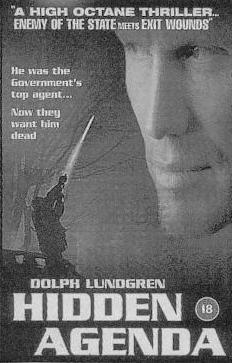 Hidden Agenda
Although some of Dolph
Lundgren's last batch of 'B' action movies have not been up to
his Rocky 4 and Universal Soldier best, Hidden
Agenda definitely delivers the goods.
Hidden Agenda
Although some of Dolph
Lundgren's last batch of 'B' action movies have not been up to
his Rocky 4 and Universal Soldier best, Hidden
Agenda definitely delivers the goods.
The story leads us onto the case
of former special agent Jason Price (Dolph) who erases identities.
If a witness wants protection or a deep-cover agent needs to
disappear, Price's Daedalus network can loose them for good.
Unfortunately a ruthless contract
killer infiltrates the network and its impregnable security is
blown, suddenly no-one under their protection is safe.
Leaving a bloody trail behind
him, the hit man threatens to destroy Daedalus and the lives
of everyone sheltering in its labyrinth of new names, new cities
and new identities.
Price is determined to stop the
killer before it's too late, and in a world of half-truths, full
blown lies and where nothing is what it seems, everyone has a
hidden agenda.
This is by far Dolph's best film
in a long time, his fight scenes are hard hitting, no fancy movies,
just get the job done action. This script is intelligent and
has hidden depths, it is a must for all action fans and a welcome
change of pace for Dolph's movie career. Definitely worth a look
for a good evening's entertainment. |











